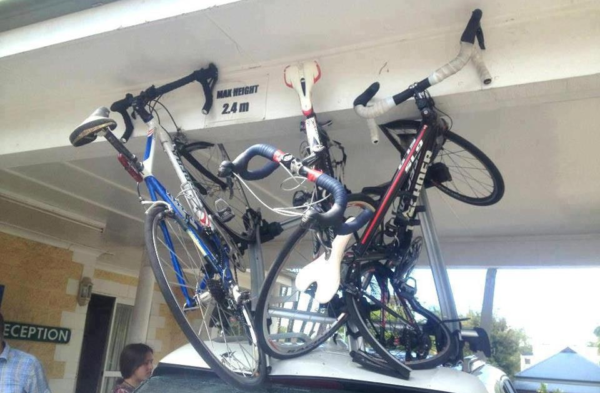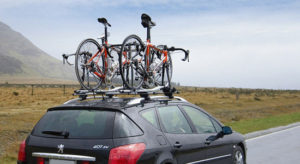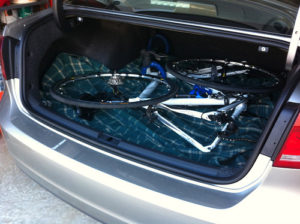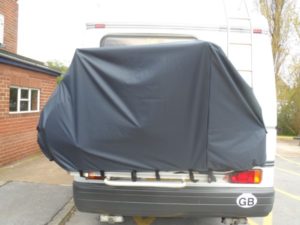Strapping your bike on your car and heading out on an adventure can be a great way to expand your cycling experience. You can find quiet roads or some new new single track and get away from your go-to routes. The only issue can be figuring out how to best protect your bike while travelling from one place to another.
There are quite a few options when it comes to transporting your bike, and you have to find what will work best for you. This will also be determined by what kind of vehicle you have. Here are some of the best ways to protect your bike and ensure your adventure isn’t tainted by a damaged or stolen bike.

Pick the Right Carrier
- Rear Mounted Carriers
Rear mounted carried are easy to use, but can have some drawbacks to consider. In most cases they limit access to the trunk or back of the vehicle, which can become an issue when it comes to gear. They are also more susceptible to damage, whether it be from dirt and rocks or an accident. You also need to ensure your plates and lights remain visible, as this can be cause for a road fine in many countries.
- Roof Racks
Not only does a roof rack tell the world that you are a fun  outdoorsy person, but the it is a great option when it comes to transporting your bike. You can either keep your front wheel on, or some require you remove the front wheel and include a fork grabber that can be locked for extra security. Although roof racks generally keep your bike a lot cleaner, it increases your wind resistance and can affect how your car handles. It can also be difficult to get your bike on and off the roof depending on the height. Plus, there is the added risk of forgetting it’s up there and driving under something (like a garage) and hearing that sickening crunch.
outdoorsy person, but the it is a great option when it comes to transporting your bike. You can either keep your front wheel on, or some require you remove the front wheel and include a fork grabber that can be locked for extra security. Although roof racks generally keep your bike a lot cleaner, it increases your wind resistance and can affect how your car handles. It can also be difficult to get your bike on and off the roof depending on the height. Plus, there is the added risk of forgetting it’s up there and driving under something (like a garage) and hearing that sickening crunch.
- In your car
 Some choose to remove the front wheel and transport their bike in the vehicle for piece of mind. Yes, this is the cheapest and perhaps the most secure method, but it does have its drawbacks. Not only can it be awkward to get your bike in and out, but it can damage your vehicle through catching material or bike grease and dirt. Also, it doesn’t leave much room for anything else if you are heading out with some friends or need other gear.
Some choose to remove the front wheel and transport their bike in the vehicle for piece of mind. Yes, this is the cheapest and perhaps the most secure method, but it does have its drawbacks. Not only can it be awkward to get your bike in and out, but it can damage your vehicle through catching material or bike grease and dirt. Also, it doesn’t leave much room for anything else if you are heading out with some friends or need other gear.
Position the Bike Correctly
Almost all bike carriers will hold the bike frame somewhere for stability. You’ll want to make sure to place the clamp as close as possible to the frame joint as that’s where the frame will be strongest. This is particularly important for carbon frame bikes.
Lock it up
If you are going to leave your bike unsupervised on your car for any amount of time then you’re going to want to lock it up. Many bike racks include a locking mechanism, but an additional lock is always a good idea. Not only does it make thieft more difficult, but it a visual deterrent to bike thieves in the first place. Whenever possible be sure to leave your car and bike in a well lit and populated area.
Keep it clean
To help avoid scratches while transporting your bike, give it a wipe down before popping it on or in your  car. This is especially important for carbon bikes. Likewise, you’ll want to keep your bike rack nice and clean to keep dirt from getting trapped between your bike and the rack. If you’re using a rear mounted bike you can also use a bike cover to keep your bike clean and protect it from incoming rocks and dust.
car. This is especially important for carbon bikes. Likewise, you’ll want to keep your bike rack nice and clean to keep dirt from getting trapped between your bike and the rack. If you’re using a rear mounted bike you can also use a bike cover to keep your bike clean and protect it from incoming rocks and dust.
No matter how far you are transporting it, make sure you take the necessary things with you to protect your bike. Always take a bike lock, at rag or wipe to give your bike a quick clean, and a bike cover if you are going to be leaving your bike out in the elements for any period of time.